The beginning of the 14th century, France at the height of its power. King Philip IV the Beautiful subjugated the Pope and seemed to be the most powerful ruler of Europe. And then suddenly there was a procession of defeats, tragedies and humiliations. In a short time, the monarchy lost almost everything. A coincidence or a curse? And what do the Templars have to do with all this?
The kings of France, from the accession to the throne of Hugo Capet in 987, for over 300 years exemplary fulfillment of the basic royal duty - they left behind their sons. In this way, they provided the state with stability that no other monarchy at that time experienced. Moreover, the younger royal sons took over numerous principalities and counties, and even foreign crowns. The success of the dynasty is guaranteed! Are you sure?
Templars Judged
In 1314 came the end of the seven-year-long, famous trial against the Templars. The Order, flooded with riches, was found guilty of heresy, sodomy and several other forbidden acts.
The lawsuit, a farce from the judiciary, was driven by the chief prosecutor William de Nogaret and by the King of France, Philip IV the Beautiful himself. Everything happened with the consent of the only person who had the right to judge the monks - Pope Clement V. To this day, the prevailing opinion is that the only fault of the Templars was that their fortune stung the eyes of the king in need of money.
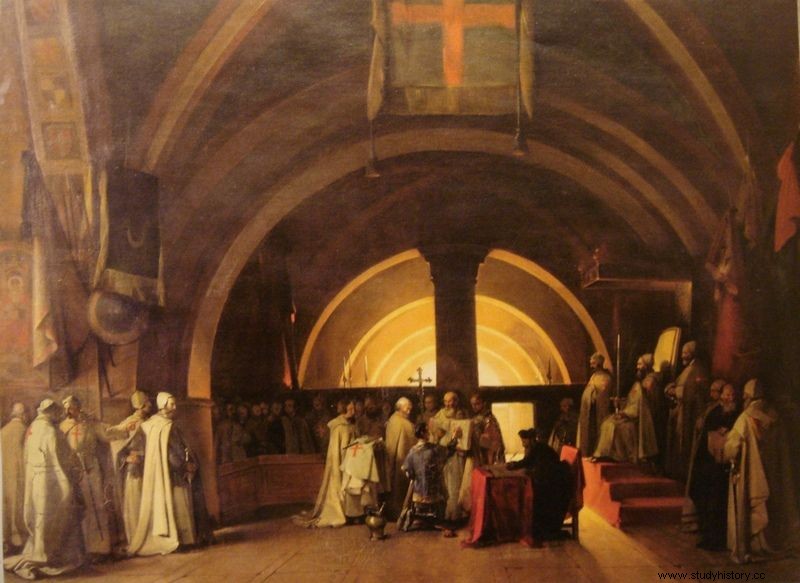
Before the trial began, the Templars were a respected order. The illustration shows a contemporary image of the ordination of Jacob de Molay by François Marius Granet (source:public domain).
The Grand Master of the Templar Order, Jacob de Molay, was burned at the stake on March 18. According to the legend, the monk standing in the flames declared his innocence and cursed his persecutors:
Pope Clement, King Philip, Knight William! Before a year has passed, we will meet in God's judgment!
Not only the trial leaders were to feel the effects of their crime. According to some accounts, the curse also extended to the descendants of the king of France up to the thirteenth generation.
Blood Harvest
Wilhelm de Nogaret, the first victim of the curse, had died before ... before it was terminated. Death caught up with him in 1313.
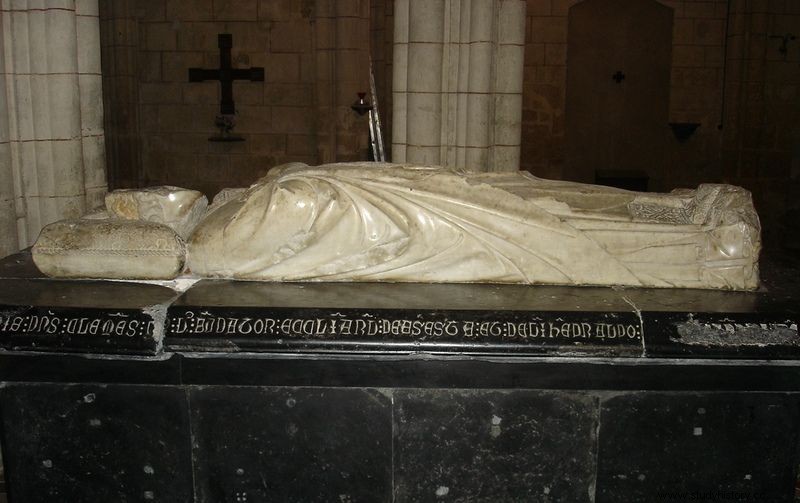
Tombstone of Pope Clement V in the collegiate church in Uzeste near Bordeaux. The church leader died just a month after de Molaya was burnt (Photo:Xabi Rome-Hérault, license CC BY 3.0).
His contemporaries were more impressed by the imminent death of Clement V. He died just a month after de Molay as a result of acute diarrhea.
In early November 1314, King Philip IV, 46, suffered an attack of apoplexy while hunting, fell off his horse and died after a few weeks of agony. This pile of corpses gave food for thought - by the end of 1314, the main part of the curse was complete.
More cursed kings?
The throne after Philip IV the Beautiful was taken over by his eldest son, Ludwik X Kłótnik. The young ruler's wife died suspiciously at an express pace, imprisoned while his father-in-law was still alive, on charges of adultery. So he took the second and ... died on June 5, 1316. He was 26 years old, and his reign lasted only a year and a half. Possible cause of his death was pneumonia.
He left behind a daughter from his first marriage and a pregnant second wife. The inheritance to the throne was suspended until childbirth. Five months after Ludwik's death, the Queen gave birth to a son. However, John I the Conqueror lived only five days.
The sudden death of three kings in two years and the dynastic crisis definitely looked like punishment from God. And this is not the end ...
Who is the throne for?
Only a minor daughter from his first marriage remained after King Louis X, who was unofficially suspected of being a bastard. Meanwhile, Ludwik's younger brother, Filip, 23, was power-hungry, grown up and had a son. At the beginning of 1317, he quickly crowned himself, more like a usurper than a rightful ruler.
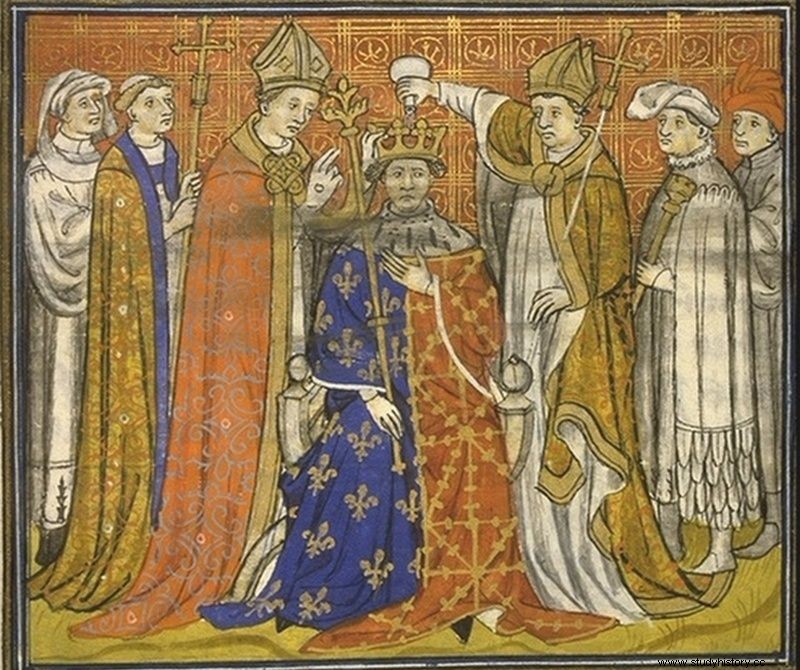
This was the hasty coronation of Philip V Long, performed just two months after the death of his nephew (source:public domain).
The new king, Philip V the Long, only later gained the support of the general assembly in Paris. Citing tribal rules, it denied Philip's niece the right to inherit the throne. According to the twisted interpretation of the "Salic law" unearthed by scholars, power could only pass through the male line.
King Philip V Long, who had an heir, could restore stability to the dynasty. It was not given to him, however - his son lived less than a year. On January 3, 1322, Philip V died after a five-year reign. He was only 28 years old, and his body was overcome with dysentery after drinking the contaminated water from the well. Four of his daughters lived then… who, due to the same law that paved the way for their father's throne, could not inherit him. As you can see, Philip was too effective in promoting his arguments.
The throne was taken over by the youngest brother, 27-year-old Charles IV the Beautiful. The childless ruler quickly divorced his wife. His second spouse died 2 years later, with the birth of a son who lived several days. He had two daughters with his third wife. She was in her third pregnancy when Charles IV died on February 1, 1328, at the age of only 33. Born 2 months later, the death child was a girl.
Thus as many as five kings of France died within 14 years. The dynasty died out, and the lack of a legitimate heir contributed to the outbreak of the Hundred Years' War.
If not by chance, then what?
As you can see, the catastrophes that had bypassed the French dynasty for centuries attacked with unprecedented force immediately after the hapless Templar was burned at the stake. Case? The superstitious French did not think so!
The sudden deaths of the powerful were usually explained by the influence of supernatural forces. Already the wife of Philip IV the Beautiful, who died in 1305, was to fall victim to witchcraft performed with the use of an object resembling a voodoo doll. Likewise, the deaths of Louis X and Philip V were ascribed to the acts of unclean powers.
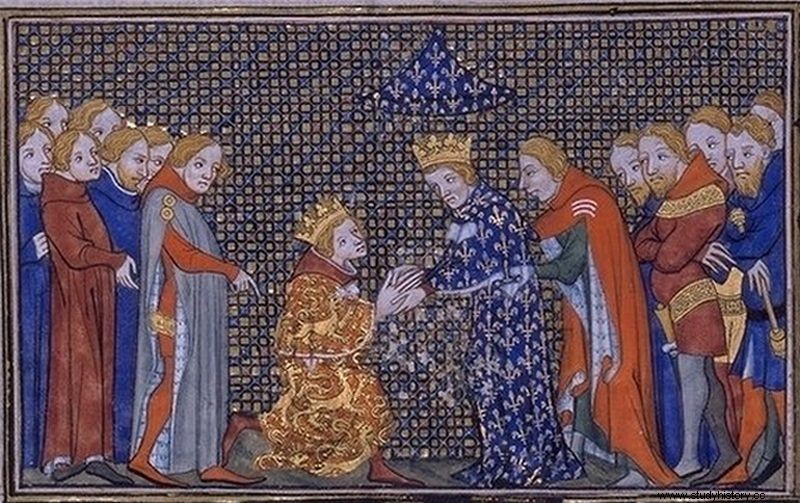
Nice bad beginnings:although the first king of the new Valois dynasty quickly received his homage from the main opponent to the throne, Edward III of England, a war broke out between them soon, which was to last over a century (Jean Froissart miniature, source:public domain).
Another frequently used explanation was poison. It was widely suspected that it was used by Pope Clement V and kings Philip IV, Louis X and John I.
Was that a curse?
The very curse in this wording, which has persisted to this day, gives the impression of a typical explanation for a people who did not want to believe in coincidence. Besides, some parts of it are objectionable.
First, Wilhelm de Nogaret died before de Molay. However, it may be suspected that the great master did not know about it.
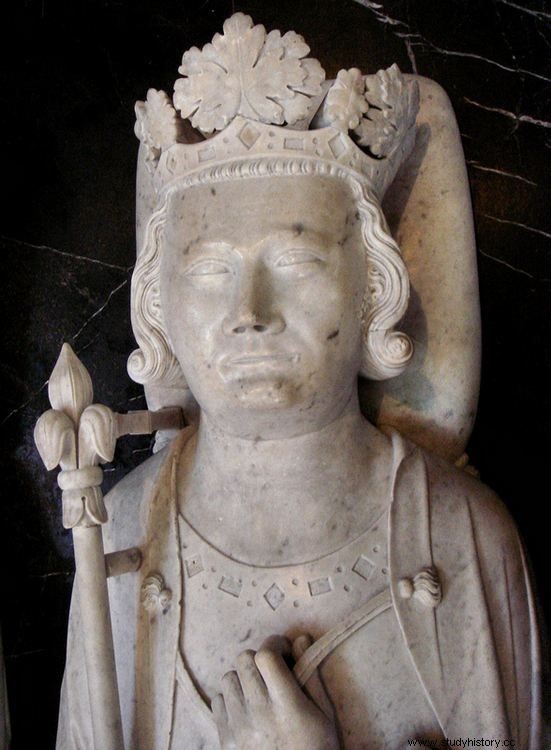
Tomb of Philip IV the Beautiful in Saint-Denis. I wonder if the author of the sculpture tried to present the ruler's reverie over the fate of his descendants (photo:PHGCOM, license GFDL).
Thirteen generations are more controversial. This is how many generations are in about 400 years. Has France been cursed all this time? Richelieu, who lived 300 years later, would probably disagree. Or maybe fate hung over all the descendants of King Philip IV the Beautiful? However, there were plenty of them, and many led happy, prosperous and even peaceful lives ...
